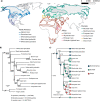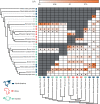The Legacy of Recurrent Introgression during the Radiation of Hares
- PMID: 33263746
- PMCID: PMC8048390
- DOI: 10.1093/sysbio/syaa088
The Legacy of Recurrent Introgression during the Radiation of Hares
Abstract
Hybridization may often be an important source of adaptive variation, but the extent and long-term impacts of introgression have seldom been evaluated in the phylogenetic context of a radiation. Hares (Lepus) represent a widespread mammalian radiation of 32 extant species characterized by striking ecological adaptations and recurrent admixture. To understand the relevance of introgressive hybridization during the diversification of Lepus, we analyzed whole exome sequences (61.7 Mb) from 15 species of hares (1-4 individuals per species), spanning the global distribution of the genus, and two outgroups. We used a coalescent framework to infer species relationships and divergence times, despite extensive genealogical discordance. We found high levels of allele sharing among species and show that this reflects extensive incomplete lineage sorting and temporally layered hybridization. Our results revealed recurrent introgression at all stages along the Lepus radiation, including recent gene flow between extant species since the last glacial maximum but also pervasive ancient introgression occurring since near the origin of the hare lineages. We show that ancient hybridization between northern hemisphere species has resulted in shared variation of potential adaptive relevance to highly seasonal environments, including genes involved in circadian rhythm regulation, pigmentation, and thermoregulation. Our results illustrate how the genetic legacy of ancestral hybridization may persist across a radiation, leaving a long-lasting signature of shared genetic variation that may contribute to adaptation. [Adaptation; ancient introgression; hybridization; Lepus; phylogenomics.].
© The Author(s) 2020. Published by Oxford University Press, on behalf of the Society of Systematic Biologists.
Figures





Similar articles
-
Recurrent introgression of mitochondrial DNA among hares (Lepus spp.) revealed by species-tree inference and coalescent simulations.Syst Biol. 2012 May;61(3):367-81. doi: 10.1093/sysbio/syr114. Epub 2011 Dec 26. Syst Biol. 2012. PMID: 22201159
-
Contrasting phylogeographic histories between the continent and islands of East Asia: Massive mitochondrial introgression and long-term isolation of hares (Lagomorpha: Lepus).Mol Phylogenet Evol. 2019 Jul;136:65-75. doi: 10.1016/j.ympev.2019.04.003. Epub 2019 Apr 2. Mol Phylogenet Evol. 2019. PMID: 30951923
-
The hidden history of the snowshoe hare, Lepus americanus: extensive mitochondrial DNA introgression inferred from multilocus genetic variation.Mol Ecol. 2014 Sep;23(18):4617-30. doi: 10.1111/mec.12886. Epub 2014 Sep 5. Mol Ecol. 2014. PMID: 25113393
-
Mitochondrial and nuclear DNA reveals reticulate evolution in hares (Lepus spp., Lagomorpha, Mammalia) from Ethiopia.PLoS One. 2017 Aug 2;12(8):e0180137. doi: 10.1371/journal.pone.0180137. eCollection 2017. PLoS One. 2017. PMID: 28767659 Free PMC article.
-
The ubiquitous mountain hare mitochondria: multiple introgressive hybridization in hares, genus Lepus.Philos Trans R Soc Lond B Biol Sci. 2008 Sep 12;363(1505):2831-9. doi: 10.1098/rstb.2008.0053. Philos Trans R Soc Lond B Biol Sci. 2008. PMID: 18508749 Free PMC article.
Cited by
-
Divergence and introgression among the virilis group of Drosophila.Evol Lett. 2022 Nov 28;6(6):537-551. doi: 10.1002/evl3.301. eCollection 2022 Dec. Evol Lett. 2022. PMID: 36579165 Free PMC article.
-
The evolutionary pathways for local adaptation in mountain hares.Mol Ecol. 2022 Mar;31(5):1487-1503. doi: 10.1111/mec.16338. Epub 2022 Jan 17. Mol Ecol. 2022. PMID: 34995383 Free PMC article.
-
Ecological Diversification in an Adaptive Radiation of Plants: The Role of De Novo Mutation and Introgression.Mol Biol Evol. 2024 Jan 3;41(1):msae007. doi: 10.1093/molbev/msae007. Mol Biol Evol. 2024. PMID: 38232726 Free PMC article.
-
Deep origins, distinct adaptations, and species-level status indicated for a glacial relict seal.Proc Natl Acad Sci U S A. 2025 Jun 24;122(25):e2503368122. doi: 10.1073/pnas.2503368122. Epub 2025 Jun 10. Proc Natl Acad Sci U S A. 2025. PMID: 40493204 Free PMC article.
-
The Genomic Landscape, Causes, and Consequences of Extensive Phylogenomic Discordance in Murine Rodents.Genome Biol Evol. 2025 Feb 3;17(2):evaf017. doi: 10.1093/gbe/evaf017. Genome Biol Evol. 2025. PMID: 39903560 Free PMC article.
References
-
- Alves P.C., Melo-Ferreira J., Branco M., Suchentrunk F., Ferrand N., Harris D.J.. 2008. Evidence for genetic similarity of two allopatric European hares (Lepus corsicanus and L. castroviejoi) inferred from nuclear DNA sequences. Mol. Phylogenet. Evol. 46:1191–1197. - PubMed
-
- Barlow A., Cahill J.A., Hartmann S., Theunert C., Xenikoudakis G., Fortes G.G., Paijmans J.L.A., Rabeder G., Frischauf C., Grandal-d’Anglade A., García-Vázquez A., Murtskhvaladze M., Saarma U., Anijalg P., Skrbinšek T., Bertorelle G., Gasparian B., Bar-Oz G., Pinhasi R., Slatkin M., Dalén L., Shapiro B., Hofreiter M.. 2018. Partial genomic survival of cave bears in living brown bears. Nat. Ecol. Evol. 2:1563–1570. - PMC - PubMed
Publication types
MeSH terms
Substances
Associated data
Grants and funding
LinkOut - more resources
Full Text Sources
Miscellaneous

